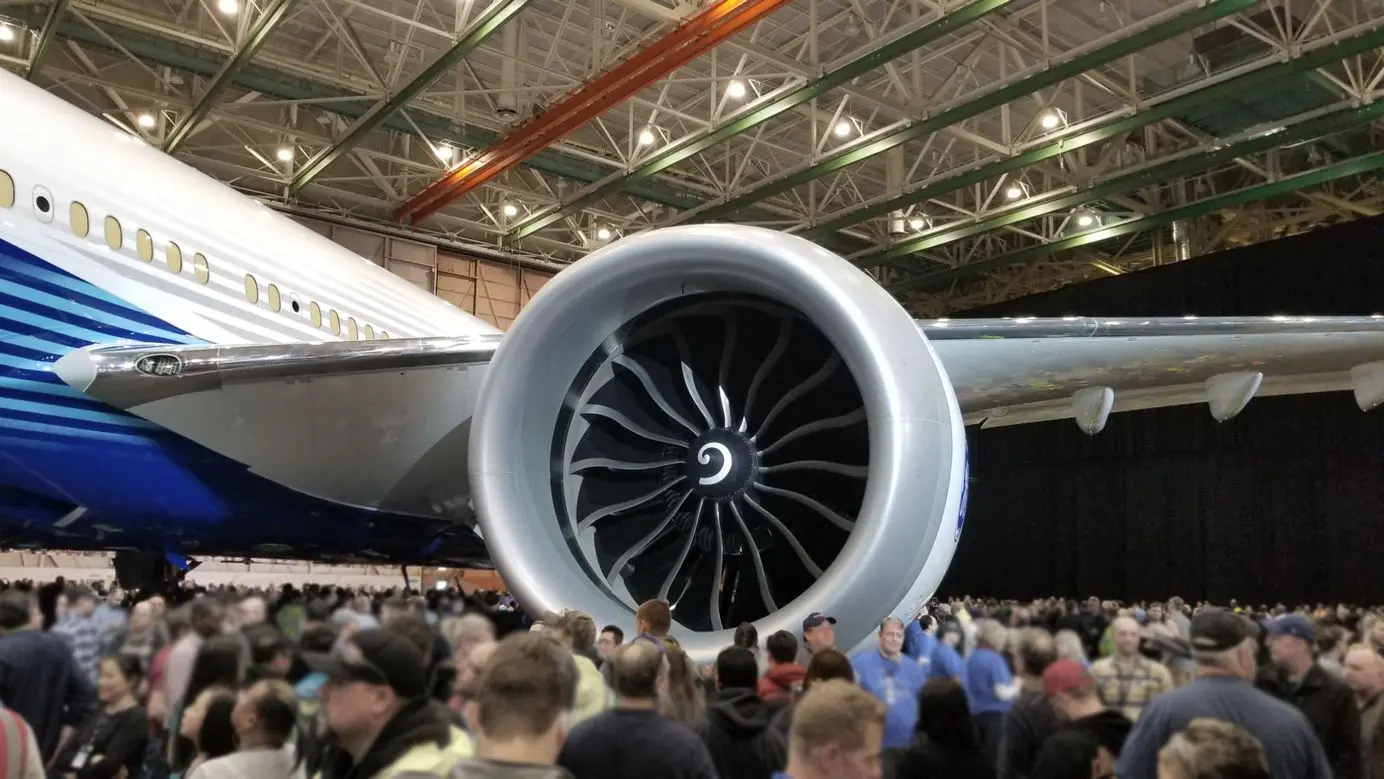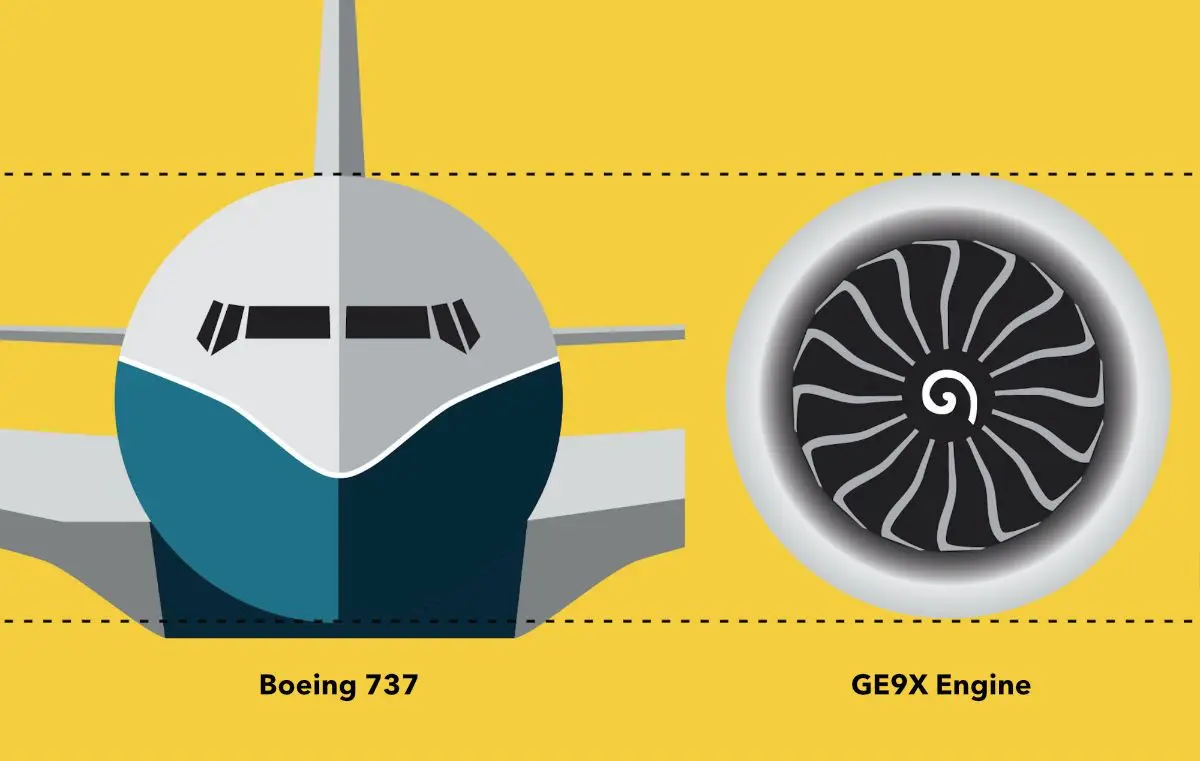
What's So Special About The GE9X Jet Engine?
It's powering the new Boeing 777X. But what's so special about the GE9X jet engine?
Table of Contents
It is the worlds most powerful commercial jet engine in aviation history. Developed by american GE Aviation, a subsidiary of General Electric, the GE9X is built specifically for the upcoming Boeing 777X wide body, twin engine aircraft. The successor to the popular Boeing 777.
Thanks to advanced technologies and material innovations, the GE9X is able to provide about 134.300 pounds of thrust. A significant 16% improvement in thrust compared to the predecessor, the GE90 that the GE9X is developed from.
But the power is not the only thing that is special about this engine. Let's explore what makes the GE9X engine so special.
| Weight | 36,000 lb or 16,300 kg |
| Fan diameter | 134 inches or 340 cm |
| Thrust | Tested to 134.300 pounds of thrust |
| Bypass Ratio | 10:1 |
| Overall pressure ratio | 60:1 |
| Application | Boeing 777X |
First, Some Background Info
The GE9X is in large parts developed from the General Electric GE90 jet engine that powers the current Boeing 777.
In 2012, GE announced the studies of a more efficient and powerful version of the GE90 to power the Boeing 777X. Initially the GE9X would feature the same fan diameter as its predecessor, 128 inches. During development, this was increased to 134 inches to improve the engines bypass ratio and thus fuel efficiency.
The Boeing 777X development program suffered some delays but the GE9X engine completed its first ground test in April 2016. Aerodynamics, mechanical systems and thermal performance was tested and the year after, the GE9X went through icing tests.
While testing the engine in extreme conditions in 2019 a component issue led to a three month delay of the engine development and testing, while a redesign was implemented.
Also in 2019 the GE9X engine received certification for being the world’s most powerful jet engine by Guinness World Records. The engine produced 134.300 pounds of thrust during a test run performed in 2017.
What's So Special About the GE9X?
Even though the engine is not introduced into service yet, it still boasts some impressive figures. The GE9X is developed for the Boeing 777X which emphasizes fuel efficiency, lower emissions and of course performance. Thus the aircraft demands a lot from its engines.
Power and Performance
First of all it's the most powerful commercial jet engine in the world. The Boeing 777X is a large aircraft and requires a high amount of thrust.
During testing, the GE9X engine reached an impressive 134.300 pounds of thrust, which in fact certified the engine as the most powerful in the world, according to Guinness World Records. To put that number into perspective, the rocket that launched the first american into space, the Mercury-Redstone 3 rocket, produced 78.000 pounds of thrust.
Most of the power comes from the record-setting 27:1 compressor ratio. This contributes to the overall engine pressure ratio of 60:1 which is the highest ever produced in aviation history. The GE9X uses 11 compressor stages instead of 9 or 10 on the predecessor GE90. This increases both the power of the engine as well as the efficiency.
Being a core component of a jet engine, the compressor squeezes air together, increases the pressure and loads it with potential energy for the combustion. The squeezed air is mixed with fuel which is ignited and expands, in turn creating thrust.
Size
With its 134 inch (340 cm) front fan, the GE9X takes the title of being the largest jet engine in civil aviation history. Everything included, the engine in its nacelle is 184 inches (467 cm) wide. That means that the whole engine is as wide as the body of a Boeing 737.

The size of the GE9X jet engine presented the development team with some unique challenges. For flight tests, it could only fit under the wing of a Boeing 747-400 equipped with bigger tires and landing gear struts.
Fan Blades
The GE9X jet engine features only 16 fan blades on the main fan disc. The predecessor GE90 has 22 and the GEnx has 18.
The lower number of fan blades benefits the overall weight of the engine. Generations of fan blade design improvements have resulted in fewer blades needed to move the same amount of air. Especially when the engine fan is now also larger on the GE9X. Blades on the GE9X are also thinner.
The lower amount of fan blades also means that the fan can spin faster. Since high amount of thrust is generated by the front fan disc, this is a big improvement to engine performance.
All GE9X fan blades are made of composite materials with the leading edges reinforced with steel to better absorb bird impacts.
Materials and Manufacturing
To create a light and efficient engine, GE incorporated the use of advanced composite materials and new ways of manufacturing.
The combuster and high pressure turbines are made of new ceramic matrix composites. According to GE this means twice the strength, a third of the weight and better thermal management than their metal counterparts. The ceramic matrix composite is able to endure temperatures where other advanced alloys become soft - Around 2.400 degrees fahrenheit. This improves engine durability and wear.
For the low pressure turbine, GE chose titanium aluminide which is stronger, lighter and more durable than their nickel-based counterparts.
Fan blades are made of carbon fiber composites and benefit the overall weight of the engine. They are also stronger and more efficient. The fan case is made of composites as well, further reducing weight while keeping the structure strong.
New ways of manufacturing also found its way to the new GE9X engine. 3D printing is used to make components that, according to GE, could not be made in other way. Traditionally these parts were casted but this is a slow and expensive manufacturing method. With 3D printing, GE engineers can develop and implement new parts and designs much faster.
The GE9X features seven 3D printed components including the fuel nozzle tip, the low pressure turbine blades and heat exchanger, parts of the debris rejection system and combustor mixer.
Debris Rejection System
To prevent harmful foreign particles to enter the engine core, the GE9X is equipped with a debris rejection system. Located in the compressor inlet, the system works by slinging particles away from the compressor stream using inertia. It forces the intake air to follow a curved path where the sudden change in direction forces particles with a mass to sling away from the air stream.
Debris such as dust, gravel and cement particles, pollution, sand and other foreign objects are prevented from entering the sensitive areas of the engine. This means less wear and in turn equals better performance retention and improved overall engine durability.
Fuel Efficiency and Emissions
As fuel costs amount to around 20% of the airline's expenses, fuel efficiency is vital for business. According to General Electric, the GE9X is their most fuel efficient engine ever. GE has designed it to be 10% more efficient compared to the GE90-115B engine that powers the Boeing 777-300ER.

Most of the increased engine fuel efficiency comes from the higher bypass-ratio design. In general, a higher bypass-ratio means a more fuel efficient engine. The GE9X engine has a bypass ratio of 10:1 meaning that 10 kg of air passes through the bypass ducts while 1 kg of air goes into the core and is mixed with fuel and ignited. The predecessor GE90 engine has a bypass-ratio of around 9:1 depending on the variant.
General Electric has equipped the GE9X with a more efficient combuster which also reduces the NOX emissions of the engine. According to General Electric, improvements to the fuel injector, fuel-air mixer and cooling is the key to the better fuel efficiency achieved by the GE9X.
Also, the use of carbon fiber composite fan blades which is lighter and thinner means a 1.5% fuel efficiency improvement alone.
What About the Future?
The GE9X is the only engine option for the Boeing 777X, which is set to enter commercial service in 2021.
Recently, the Boeing 777X has faced some challenges in demand and some airlines have cancelled some orders as well. As of March 2022 the order book contained 334 aircraft. Each equipped with two GE9X engines.
The COVID-19 pandemic might certainly have caused further setbacks to the Boeing 777X program. And perhaps the order book as well. Time will tell.
Planenerd Newsletter
Join the newsletter to receive the latest updates in your inbox.






